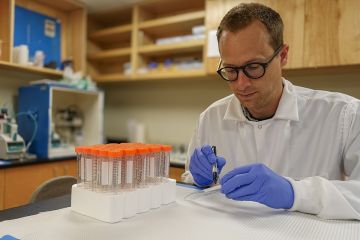Earth’s long-term climate stabilized by clouds
- Alf Wilson

Climatologists have a Precambrian problem: early in Earth’s history the sun was dimmer, but the Earth wasn’t colder. Conventional explanations of this “faint young sun problem” rely on greenhouse gas (GHG) concentrations like carbon dioxide (CO2) in the Earth’s atmosphere to increase temperatures from a stronger greenhouse effect.
In their recent Nature Geoscience publication, University of Victoria School of Earth and Ocean Sciences associate professor Colin Goldblatt, former undergraduate student Victoria McDonald, and collaborator Kelly McCusker of the Rhodium Group, showed that low clouds and, more importantly, their absence have played a critical role in keeping the early-Earth warm. Further, they found that systemic changes to low clouds have been stabilizing the climate over the entirety of Earth’s history—adding an important piece to the puzzle of how climate has evolved on Earth.
Clouds have long been one of the most difficult aspects of the past climate to understand. We all know that they are ephemeral and the problem is that means that they don’t leave a record in the rocks. But the physics doesn’t change, so modern climate models can help us understand the past.
—Colin Goldblatt, UVic School of Earth and Ocean Sciences associate professor
The researchers ran the same atmospheric models that are used to model climate change. By varying solar radiation and CO2 over time they showed that low-cloud abundance has always been vital to stabilizing the Earth’s temperature. Low-cloud decks have a high albedo—they reflect a lot of light—so the Earth absorbs less of the sun’s energy. Similar to putting a reflective shade in a vehicle window, the planet warms less because more of the sun’s energy is reflected.
Goldblatt’s team showed that a substantial decrease in low-level clouds could explain 40 per cent of the faint-sun discrepancy. This means that three times less CO2 would have been needed to keep the early Earth warm. So, while the greenhouse effect was still critical—the transient low-cloud bank has been much more important than previously thought.
“Studying climate through Earth’s whole history is like watching the feature-length movie—not just the few-second clip that the historical record gives us. So, it’s part of the context of understanding modern day climate change, something that matters to all of us,” says Goldblatt.
It isn’t that GHGs weren’t involved. The greenhouse effect plays an important role in the abundance of low clouds. Higher levels of CO2 in the paleo-atmosphere caused a stronger greenhouse effect that inhibited low-cloud formation. On the same timescales that the sun got brighter, geochemical feedbacks reduced GHG concentrations and the greenhouse effect. This made conditions favourable for increased low-cloud formation and kept the Earth from overheating as the sun became brighter.
“All parts of the Earth’s climate system are connected,” says Goldblatt. “Studying how they link together on Earth, and even on other planets, help us understand and respond to the climate crisis.”
Photos
In this story
Keywords: climate, research, environment, earth and ocean sciences, community, international, sustainability, administrative, student life
People: Colin Goldblatt, Victoria McDonald
Publication: The Ring





